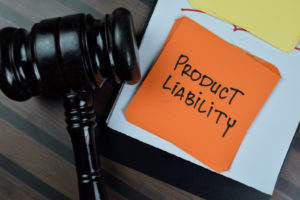 Manufacturers and those involved in the distribution chain have a legal obligation to bring products to market that are safe for public use or consumption. This often involves various tests to ensure safety. Product manufacturers who bring defective products to market put consumers at risk for injury and sometimes death and open themselves to liability for damages related to the harm their product caused someone.
Manufacturers and those involved in the distribution chain have a legal obligation to bring products to market that are safe for public use or consumption. This often involves various tests to ensure safety. Product manufacturers who bring defective products to market put consumers at risk for injury and sometimes death and open themselves to liability for damages related to the harm their product caused someone.
The legal community has divided product defects into three main categories: design defects, manufacturing defects, and information defects, which are sometimes referred to as marketing defects.
This categorization makes it easier to determine liability for a defective product injury and helps pinpoint a specific cause for the defect and injuries. Some products might have more than one type of defect; they are not mutually exclusive.
Below our product liability lawyers offer an in-depth explanation of each type of product defect, how they impact a product liability claim after suffering harm, and who could be liable in a product liability lawsuit.
Table of Contents
- Design Defects
- Manufacturing Defects
- Information/Marketing Defects
- Liability in Product Defect Lawsuits
- Possible Defendants in Product Liability Lawsuits
Design Defects
A design defect refers to a product defect that occurs during the design or conceptualization phase of a new product. In theory and/or on paper, engineers and designers come up with an idea that appears to work well. Design flaws occur long before a product gets made or distributed.
Those at the table often consider safety issues, but they sometimes miss them. From a legal standpoint, the defining characteristic of a design defect is something in the design of a product that causes it to be unreasonably dangerous to those who use or consume the product.
Many companies voluntarily recall products once they discover a flaw, sometimes before anyone suffers harm. Unfortunately, this is not always the case. Other companies don't know of the issue or don't fix a known defect until consumers have suffered serious injury or death from their products.
Famous Design Defects
Design flaws are part of the process of creating a new product. The hope is that creators, engineers, and manufacturers work all the flaws out before they release the product for public use or consumption.
When they fail, the consequences can be severe and sometimes fatal. Throughout the years, many companies have released defective products and been involved in product liability lawsuits because of defective designs. Two high-profile cases involving design defects include Bumbo baby chairs and Blitz plastic gas cans.
Bumbo chairs are foam chairs for infants. The company recalled one million chairs in 2007 and an additional four million chairs in 2012 after reports that babies were falling out of the chair and suffering skull fractures. The company marketed the chair as handy seating for parents that helped infants sit upright without being in a height chair. However, the design did not have safety straps or take into consideration that infants could fall out of the foam chairs so easily.
Blitz was involved in dozens of lawsuits alleging they knowingly sold defective gas cans that could explode, causing severe, catastrophic, and fatal injuries. The design of their popular gas cans did not include a flame arrester, which is a safety device to protect users from explosions by preventing a flame from entering the can.
Examples of Other Design Defects
Various products can have design defects.
Some more general examples include:
- Poorly designed safety features on power tools
- Furniture that topples over because of an unstable design
- Highly flammable clothing
- Electric appliances that melt on high heat settings
- Toys with choking hazards
- Inadequate packaging design for toxic and dangerous substances
- Dangerous side effects in medication and hidden defects in medical devices
Manufacturing Defects
Manufacturing-related product defects occur when a company is constructing or producing a product. In these situations, a product typically has a safe design, and the defect gets introduced during the manufacturing phase. One of the major differences between a design defect and a manufacturing defect is that latter might not impact every product.
For example, consider a company that mass produces desk chairs for a home office. One day, one of the machines that fasten pieces of a chair together malfunctions, and pieces get attached unevenly. The company eventually realizes the issue, so they implement a product recall of the defective chairs. In this situation, only the chairs constructed when the machine was malfunctioning are defective, not every single chair the company made.
Sources of Manufacturing Defects
Manufacturing issues that lead to dangerous products emerge from different activities and scenarios depending on the production process. Situations that can lead to manufacturing defects include:
- Using substandard materials
- Using the wrong materials
- Improper construction
- Poor assembly
- Human error, including missing pieces, bad welds, and damage
- Machine malfunctions
In many cases, quality control practices catch manufacturing issues and prevent defective products from reaching consumers. If the public uses or consumes a product with a manufacturing defect, it's often a result of poor quality control.
Famous Manufacturing Defects
History is chock full of minor and major manufacturing errors, some of which have led to serious injuries. Two high-profile product liability cases iinclude General Motors (GM) ignition switches and Toyota accelerators.
GM recalled about 800,000 vehicles because of faulty ignition switches. Drivers faced the risk of accident and injury because the faulty switches caused engines to quit during operation, preventing airbags from engaging during a crash.
GM had to pay hundreds of millions in wrongful death and accident injury damages as well as a $900 million settlement to the Department of Justice to avoid criminal prosecution because they hid the defect from consumers.
Setting the precedent for the case against GM, Toyota paid more than a billion-dollar fine after recalling millions of cars, not including the hundreds of lawsuits they settled.
Several models of Toyota cars had sticky accelerator pedals, causing cars to accelerate even when braking. In many cases, the cars stopped only after crashing into something, leading to catastrophic and fatal injuries.
Lawyers who brought lawsuits against Toyota argued that the company could have prevented accidents by installing a safety mechanism to decrease the chances of an accident if the gas pedal malfunctioned. Toyota also faced criminal charges because they allegedly knew about the defect and chose not to take immediate action, instead blaming the problem on driver error.
Information/Marketing Defects
Information defects refer to defects related to instructions for use and marketing information for a particular product. Manufacturers have a legal duty to warn users and consumers about dangerous aspects of their products.
Think about some of the products you use in your home regularly. You've likely seen warnings on products that could be a choking hazard, fire hazard, or poison hazard. Additionally, manufacturers must provide instructions for use when it applies.
Scenarios that lead to information and labeling defects include:
- Failure to provide instructions
- Failure to properly label products, especially relevant to food, chemicals, and pharmaceuticals
- Failure to provide warnings about hazardous products or hazardous aspects of products
- False claims about the safety of a product
Courts generally consider products as having a labeling defect if the manufacturer could have prevented injury or death by providing consumers with more information.
Famous Information Defects
Several companies have been involved in lawsuits because their failures in marketing and information led to injury or death when people used or consumed their products.
One of the highest value and highest profile information defect claims involved Philip Morris tobacco company. A court ordered Philip Morris to pay $28 billion in damages to a Missouri woman who sued the company for her addiction to tobacco.
The woman’s legal team argues that Philip Morris failed to warn her about the risks of smoking and concealed the dangers with widespread misinformation that the company began spreading in the 1950s. Philip Morris appealed the case and settled for a much lower amount, $28 million. However, Philip Morris continues to get sued for their failure to warn people about the risks of smoking.
Another example of a marketing defect involves Johnson & Johnson baby oil. The company marketed the oil as “pure and gentle,” providing a false sense of security for users in all situations, and they did not provide any warnings. Unfortunately, a baby swallowed some oil and also got some oil in its lungs. The mother did not take immediate action because she believed the baby oil was safe. However, this was not the case, and the 15-month-old suffered severe brain damage.
Liability in Product Defect Lawsuits
The biggest way that the type of defect impacts a product liability claim lies in whether the product has an information defect. Most product liability cases focus on design and manufacturing defects, but marketing defects play a role in many claims, especially when a company fails to warn consumers or provide instructions. Additionally, information and marketing defects open up more avenues for legal teams to find company statements that show they knew about potential issues and did not offer warnings or instructions.
Strict Liability and Negligence
Most product liability suits are brought under strict liability or negligence theories of liability. If you suffered injuries from a defective product, you must prove the company was negligent to win your case. However, in some situations, strict liability applies, and negligence does not play a role. The company is responsible for damages even if it did not willfully sell, market, or distribute a defective product.
Breach of Contract
Bringing a product liability lawsuit on the bases of breach of contract most often occurs when information defects are present. All statements made during the sales process and language in the warranty can serve as grounds for oral or written breach of contract.
Breach of contract product liability claims that focus on warranty issues deal with the breach of express and implied warranties.
- Express warranties include all facts and promises made to a buyer, descriptions of goods, and samples or models. Companies must conform to these facts even if they do not use the word “warranty” or “guarantee.” The appearance of products, sales and marketing literature, websites, and statements from salespeople can create an express warranty. This also opens up distributors and retailers to liability for damages.
- Implied warranties include items consumers infer or assume minus any disclaimer the company has made about their products. Because an implied warranty relies on interpretation, it’s often harder to prove a company breached an implied warranty.
Fraud and Misrepresentation
All types of product defects can result in a product liability lawsuit based on fraud and misrepresentation. Like the GM and Toyota examples above, the Department of Justice might get involved and also pursue criminal action.
Manufacturers commit fraud when they knowingly bring defective products to market, make intentional false claims in their marketing material, or fail to take action when they receive reports and complaints of consumer injury or death.
Fraud claims are a type of negligence claim in which a product liability lawyer must prove that negligent misrepresentation caused harm to someone. These claims are not as common as ordinary negligence or strict liability claims because they come with a heavy burden of proof.
Possible Defendants in Product Liability Lawsuits

After suffering injuries from a defective product, most people look to blame the manufacturer. However, any party involved in bringing a product to the public for use or consumption can be liable for damages related to defective product injuries.
Possible defendants in a product liability claim include:
- Product Manufacturers. Any company that designs, builds, formulates, and markets a consumer product can be liable in a product liability lawsuit. This includes small businesses running out of a home or garage to large multinational conglomerates.
- Product Distributors. Wholesalers and distributors who knowingly distribute a defective product could share liability with the product manufacturer.
- Product Retailers. Retailers who sell products they know are unsafe or make claims about a product’s safety could be liable for damages even though they did not design or manufacture the product.
Product liability lawsuits are complex cases that often involve multiple parties. If you have suffered harm from the use or exposure to a defective product, contact an experienced product liability lawyer as soon as possible to learn more about your legal options.
